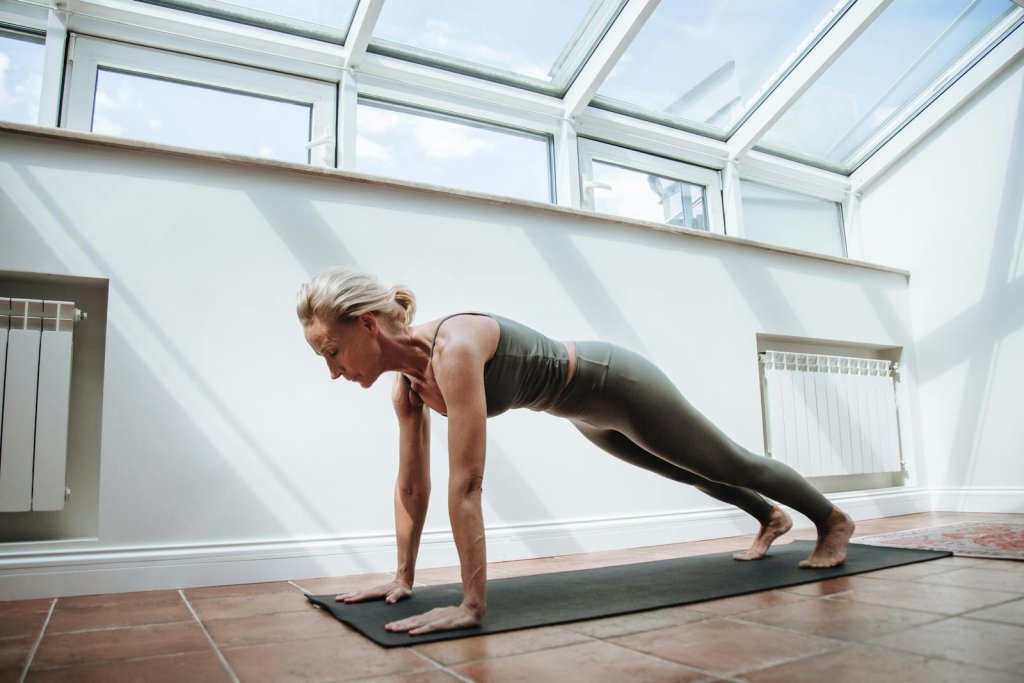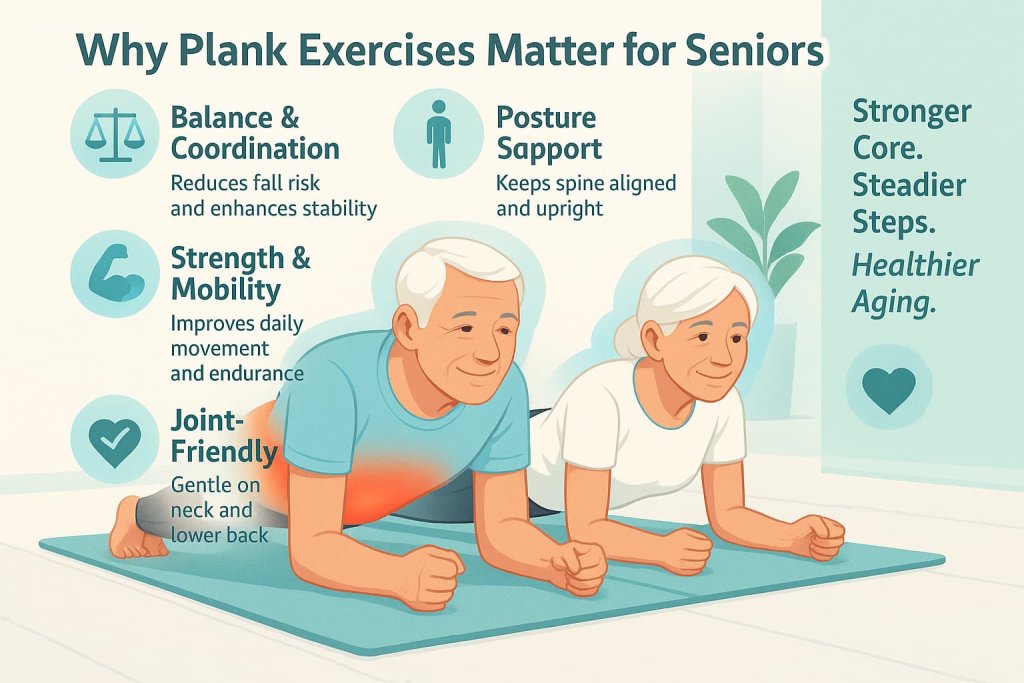Plank exercises are one of the safest and most effective ways for seniors to strengthen the core, improve balance, and protect the spine.
Unlike sit-ups or crunches, planks engage the entire trunk — including the abdominals, lower back, hips, and shoulders — without straining the neck or compressing the spine. A strong core helps older adults stay steady on their feet, maintain good posture, and move with confidence.

Research from Harvard Health Publishing (2021) confirms that planks outperform traditional ab exercises in improving total-core stability for older adults. Similarly, a 2023 PubMed study found that regular plank practice in older adults enhanced respiratory capacity and physical fitness.
In this guide, you’ll learn 10 safe, senior-friendly plank variations with tips for form, progression, and injury prevention.
Why Plank Exercises Matter for Seniors
A strong, stable core supports nearly every movement — from walking and bending to standing up from a chair. With age, the trunk muscles naturally weaken, which can affect posture, balance, and even breathing.

Evidence-Based Benefits:
- Improved Balance & Coordination: Core strengthening helps reduce fall risk by stabilizing the trunk. (BMC Geriatrics, 2025)
- Better Posture: Planks align the spine and strengthen muscles that support upright movement.
- Enhanced Mobility & Strength: A 2025 Frontiers in Physiology study linked consistent core training to improved trunk control in adults aged 60 +.
- Safer Alternative to Crunches: Planks minimize neck and lower-back strain compared to sit-ups.
Safety and Precautions
Before beginning plank training:

- Consult a doctor or physical therapist if you have osteoporosis, spinal arthritis, hernia, or shoulder pain.
- Warm up with gentle marches, arm circles, or torso rotations for 3–5 minutes.
- Start with short holds (10–20 seconds) and gradually build to 30–45 seconds.
- Focus on form over duration — a straight spine and gentle breathing matter most.
- Use a mat, soft surface, or wall for extra support.
How to Do a Plank Safely

- Position: Align head, shoulders, hips, knees, and ankles in one line.
- Core Engagement: Gently tighten your stomach as if pulling your belly button toward your spine.
- Breathing: Maintain steady breaths — never hold your breath.
- Finish: Rest between sets; stop if you feel back pain or dizziness.
10 Best Plank Exercises for Seniors
These 10 plank variations are safe, effective, and adaptable for every fitness level.
Each move helps seniors build core strength, improve balance, and support better posture with minimal joint strain.
1. Wall Plank (Beginner-Friendly)
Why it works:
This upright variation minimizes wrist and shoulder strain while teaching proper plank alignment. It strengthens your core, shoulders, and chest without requiring you to get down on the floor — ideal for beginners or anyone with limited mobility.
Muscles worked:
Core stabilizers, shoulders, pectorals, and upper back.
How to do it:
- Stand arm’s length away from a wall.
- Place palms flat at shoulder height, fingers spread for balance.
- Step feet back slightly until your body forms a straight line from head to heels.
- Tighten your core and hold for 20–30 seconds.
- Rest and repeat 2–3 times.
Trainer Tip:
Keep a gentle bend in your elbows and exhale steadily — focus on pulling your belly button slightly toward your spine for deeper core engagement.
2. Incline Plank on Table or Bench
Why it works:
This plank reduces the amount of body weight you support, allowing you to build endurance safely. It’s great for developing strength before progressing to floor planks.
Muscles worked:
Abdominals, shoulders, chest, and triceps.
How to do it:
- Place your hands shoulder-width apart on a sturdy table, bench, or countertop.
- Walk your feet back until your body forms a straight line from head to heels.
- Engage your abs and glutes to avoid sagging hips.
- Hold 20–45 seconds; repeat 2–3 sets.
Trainer Tip:
Imagine forming a “ramp” from your heels to your shoulders — this mental cue helps keep your posture tight and aligned.
3. Forearm Plank (Modified on Knees)
Why it works:
This is a gentle yet effective version that strengthens deep abdominal muscles while protecting the lower back and wrists.
Muscles worked:
Rectus abdominis, transverse abdominis, obliques, and shoulders.
How to do it:
- Kneel on a mat and lower your forearms to the floor, elbows under shoulders.
- Keep knees and toes on the ground, forming a straight line from head to knees.
- Draw in your abdomen and breathe evenly.
- Hold 15–30 seconds; rest, then repeat.
Trainer Tip:
Keep your gaze slightly ahead of your hands to maintain a neutral neck. Avoid lifting your head or letting your back round.
4. Side Plank on Knees
Why it works:
Targets the obliques and side stabilizers of your spine — crucial for maintaining balance and preventing falls.
Muscles worked:
Obliques, gluteus medius, shoulders, and core.
How to do it:
- Lie on one side with your elbow under your shoulder.
- Bend knees 90 degrees and stack hips.
- Lift your hips off the mat, forming a straight line from shoulders to knees.
- Hold 15–30 seconds per side; repeat twice.
Trainer Tip:
Press your bottom knee and forearm firmly into the floor to stabilize your base. Keep the top shoulder stacked directly over the bottom one.
5. High Plank (Hands & Toes)
Why it works:
A full-body challenge that builds strength through the arms, shoulders, and core while enhancing joint stability and bone density.
Muscles worked:
Core, shoulders, triceps, chest, and glutes.
How to do it:
- Begin in a push-up position, arms straight, hands under shoulders.
- Keep your body in one line from head to heels.
- Engage your abs and squeeze glutes.
- Hold for 20–40 seconds, breathing deeply.
Trainer Tip:
If your wrists feel strained, make fists or lower to forearms. Spread fingers wide to distribute pressure evenly.
6. Bird-Dog Plank
Why it works:
Combines balance, stability, and coordination — teaching the core to stabilize while the limbs move. Excellent for posture and everyday control.
Muscles worked:
Core, glutes, lower back, and shoulders.
How to do it:
- Start in a high or forearm plank.
- Lift your right arm and left leg slightly off the floor.
- Hold for 2 seconds, return to start, then switch sides.
- Perform 8–10 alternating reps.
Trainer Tip:
Keep hips square to the floor. Move slowly — quality of movement is more important than height of lift.
7. Reverse Plank (Seated Bridge)
Why it works:
Strengthens the entire back side of your body — glutes, hamstrings, and spine — which are often weak in older adults due to prolonged sitting.
Muscles worked:
Glutes, hamstrings, spinal extensors, shoulders.
How to do it:
- Sit on the floor with legs straight and hands behind hips, fingers pointing toward feet.
- Press into your hands and heels, lifting hips until your body forms a straight line from head to heels.
- Hold 15–30 seconds; repeat 2–3 sets.
Trainer Tip:
Keep your chin slightly tucked and avoid letting your hips sag. Focus on squeezing glutes throughout the hold.
8. Knee-to-Elbow Plank (Gentle Mobility)
Why it works:
Adds gentle rotational movement to improve flexibility and core coordination — beneficial for spinal mobility.
Muscles worked:
Obliques, lower abs, and hip flexors.
How to do it:
- Begin in a modified or full plank.
- Slowly bring one knee toward the same-side elbow.
- Return to starting position and switch sides.
- Perform 8–12 alternating reps.
Trainer Tip:
Move with control, not speed. Visualize your ribs and hips drawing closer together as you bring the knee forward.
9. Elevated Side Plank on Chair
Why it works:
Using a chair provides support while allowing you to train lateral core strength and balance safely.
Muscles worked:
Obliques, glutes, deltoids, and core stabilizers.
How to do it:
- Stand beside a sturdy chair and place your forearm on the seat.
- Step feet out and stack hips and shoulders.
- Lift hips slightly to form a diagonal line.
- Hold 15–30 seconds per side.
Trainer Tip:
Keep your chest open — don’t roll forward. If balance is difficult, stagger your feet instead of stacking them.
10. Plank with Shoulder Tap (Optional Advanced)
Why it works:
Adds gentle dynamic movement that trains stability, coordination, and anti-rotation control — excellent for maintaining spine safety during real-life activities.
Muscles worked:
Core, shoulders, triceps, and upper back.
How to do it:
- Begin in a high plank, feet shoulder-width apart.
- Tap one shoulder with the opposite hand, keeping hips still.
- Alternate sides slowly for 8–10 taps total.
Trainer Tip:
Widen your stance for better balance and avoid rocking side-to-side — the goal is stillness, not speed.
Common Mistakes to Avoid
- Letting hips sag or pike up.
- Holding breath during the plank.
- Straining neck by looking forward.
- Over-arching the lower back.
- Ignoring shoulder discomfort — modify immediately.
Progression Plan
| Week | Variation | Duration | Frequency |
|---|---|---|---|
| 1–2 | Wall Plank / Kneeling Plank | 15–20 s | 3× week |
| 3–4 | Incline / Side Plank | 25–30 s | 3–4× week |
| 5–6 | Full Forearm / Reverse Plank | 30–45 s | 4× week |
| 7 + | Add Bird-Dog or Shoulder Taps | 45–60 s | 4× week |
FAQ
1. Are planks safe for seniors with back pain?
Yes — if performed with proper form and under professional guidance. Begin with wall or knee planks to reduce strain.
2. How often should seniors do planks?
2–4 times per week is ideal. Rest at least one day between sessions.
3. How long should I hold a plank?
Start with 10–20 seconds and gradually increase as strength improves.
4. Can planks help prevent falls?
Yes. Stronger core and hip muscles enhance balance, coordination, and reaction time.
5. What if my wrists hurt during planks?
Try forearm or fist planks, or use a rolled towel under wrists for cushioning.
6. Do planks replace other exercises?
No — combine them with walking, flexibility, and light resistance training for total fitness.
7. Can I do planks every day?
Short daily sessions are fine if your muscles recover fully; otherwise alternate days.
Conclusion
Plank exercises offer seniors a low-impact, evidence-based way to stay strong, balanced, and confident. With gentle modifications and steady practice, you can strengthen your entire core safely — improving posture, movement, and independence at any age.
Start today with a wall or knee plank — small steps build lasting strength.
References
- Park S. et al., 2023 — Plank exercise in older adults
Direct evidence: plank training improved respiratory capacity, overall fitness, and immune markers in seniors.
https://pubmed.ncbi.nlm.nih.gov/38188128/ - Park S. et al., 2024 — Randomized trial of plank training
RCT support for structured plank programs improving respiratory capacity via core adaptations.
https://pmc.ncbi.nlm.nih.gov/articles/PMC11235748/ - BMC Geriatrics, 2025 — Exercise modalities & balance in healthy older adults
Shows exercise (including core training) improves balance in community-dwelling seniors.
https://bmcgeriatr.biomedcentral.com/articles/10.1186/s12877-025-06212-0 - Rodríguez-Perea Á. et al., 2025 — Validity & reliability of the Front Plank Test
Establishes the front plank test as a valid/reliable trunk assessment across adults.
https://www.mdpi.com/2076-3417/15/5/2722
